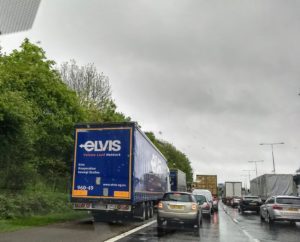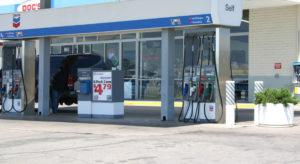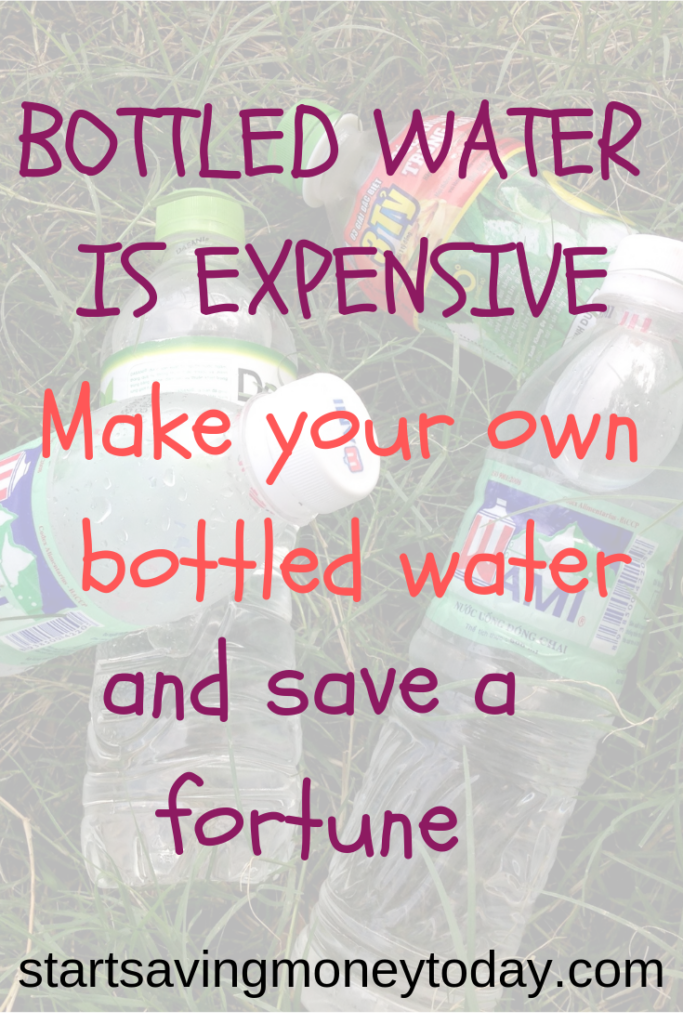Bottled water is expensive: How to be frugal
Have you bought a bottle of water recently? How much did you pay for it? Oh, my gosh! If you buy them very often, you’re spending a small fortune. Bottled water is expensive. That’s certainly not frugal . . .
Sure, at $1.60-ish per bottle (or more) it doesn’t look bad in the convenience store, but many of us buy several a day. You can get a “break” when you purchase bottled water by the case at the grocery store, but if you think about it, even then, it’s expensive. Shortly, I’ll explain how you can make “bottled water” (Note: Basically “bottled water means purified/clean water.) at home and save (a lot of) money by being frugal minded. First, let’s just talk about the product.
Price per gallon
I shopped online to find the cheapest bottled water I could. I found it at Walmart. I found “Great Value Purified Drinking Water.” One case of 24 bottles (the 16.9 oz size) was $2.48. At that price, you’re paying 78 cents per gallon for water.
How much water really costs
According to the American Water Works Association tap water (and all the chemicals in it) on the average costs only $0.004 a gallon. To show you the price difference between the cost of water that comes out of your tap and what you pay for bottled water look at it like this: With the amount of money you paid for one gallon of that bottled water from Walmart, you could have bought 195 gallons of tap water.
Bottom line: Purchased, bottled water is expensive compared to tap water, but here is a frugal way to get bottled water.
Why is bottled water so expensive
The manufacture and distribution of bottled water is a business, and all businesses have expenses. Some of these expenses involve acquiring the water and bottles, everything associated with manufacturing and distributing, including equipment, facilities, labor and management. To me it’s mind boggling to think about all the factors that go into this. Just off the top of my head, I can think of utilities, salaries and wages, (various) insurances, advertising . . . These costs and more, along with a variety of expenses incurred at store-level have to be covered by the price customers are charged. (And at the end, there’s usually a sales tax tacked on at the cash register.)
I think I’ll touch on some of these things that go into making bottled water—not specific costs, that might result in a post that never ends. I’d just like to give you an idea about what’s involved that makes bottled water expensive.
Manufacturing
Manufacturing is a huge process. Water has to be acquired, and run through the any number of possible purifications, all of which require equipment and some type of filtering materials. Then, there are the bottling and labeling procedures.
labeling procedures.
Equipment
As I just mentioned, there’s equipment involved in the water purification process. Anytime you have equipment, you need technicians to repair and calibrate that equipment. The equipment and its maintenance both cost money.
Employees
Techs and maintenance people are only a few of the employees needed in manufacturing. Others include people who run the machines that produce the product, package the individual units, and ready it for transportation. Also, labeling has to be done somewhere in the process. And you can’t forget the office and management personnel, or the cleaning staff. A lot of man hours go into manufacturing and distributing bottled water. (We can’t forget the place where the point of sale occurs; they have their own facilities and employees.) Everybody has to be paid—salary or wages, and benefits.
Advertising
Bottled water advertisements can be seen everywhere. There are billboards, illuminated signs in restaurants, radio and television commercials, and printed ads. All of which present their own sets of people, equipment, and space that have to be paid for. Advertising is expensive.
Transportation
Various brands of bottled water get shipped to many outlets, sometimes all over the country (or all over the world.) Again, there are the issues of paying for people and equipment. Transportation is costly.
The most common mode of transportation is truck or rail. The average price for trucks is $1.60 per mile.
According to thrillist.com the most of bottled water in the United States is Aquafina. It’s a PepsiCo product produced in Wichita, KS. How much would it cost to drive a truck from Wichita to where you live? –For most of the country it would be a fairly long drive, and every mile adds to the cost we pay. (Note: You’ll find that the price of the product is fairly stable across most of the country. That’s the result of cost averaging.)
Storage
Most products are manufactured and shipped to a storage facility close to where they are expected to be used. Bottled water is no exception. Usually, it’s processed, bottled, and shipped to a market area. This can be done before the product is actually sold. Of course, storage and handling costs will be applied (and eventually passed on in the end to customers). When the product is sold it will be delivered to the retail facility.
Shareholders/owners
If you are an owner or shareholder in a company that produces bottled water, you want to see a profit on your investment. Anyone who has an investment wants to make money, and that influences pricing.
This list is a really condensed list, but you can see why bottled water is expensive
Why do people drink overpriced water
Production, distribution, and other pre-purchase costs aren’t the only things that influence price, so do certain attitudes and practices of the people who buy it.
Convenience
You’re on the road. Maybe you’re driving your car, riding your bicycle, or walking. You get thirsty, so you decide to stop and buy a bottle of water at the next convenience store you come across. (It shouldn’t take long to find one, gas  stations, grocery stores and drug stores seem to be everywhere.) And why not? At under $2.00 a bottle, the cost doesn’t feel expensive, but do a little research: In psych books and on the internet you can find a number of studies that say our feelings often run contrary to fact.
stations, grocery stores and drug stores seem to be everywhere.) And why not? At under $2.00 a bottle, the cost doesn’t feel expensive, but do a little research: In psych books and on the internet you can find a number of studies that say our feelings often run contrary to fact.
Convenience often means pricey.
Fashion
It seems like everyone is drinking bottled water. Popularity can influence price.
Taste
Some people claim that bottled water tastes better than tap water. Ok . . . I’ve been in parts of the country where the water tasted different than what I was used to. I’m not sure it tasted bad, just different. However, if you think your tap water tastes bad, then it tastes bad. Bottled water may be just the thing you need.
If a lot of people prefer something, manufacturers and retailers see nothing wrong with capitalizing on that preference.
Health
Some bottled water manufacturers advertise their product as “better for you than tap water.” Just for your information: All drinking water in the United States must be approved by the EPA. But . . . with all of those advertisements saying how important water is for us and how bad tap water is, it makes sense that plenty of people choose to drink bottled on a regular basis. Everyone wants what’s best for their health. We need water and we need it to be drinkable.
Again, if a product is deemed necessary, suppliers often work on the supposition that we’re very willing to pay for it.
I’m not going to argue about it.
There are a number of compelling arguments as to both why bottled water is better for you and why it tastes better than tap water. For the purposes of this article, I’m not going to argue any of those points. I will say, however, I know you can make the water from your tap just as clean as the bottled water you purchase—and it will taste good. I know how you can make it for less than what the store charges for commercially produced bottled water.
Three ways to make your own “bottled water”
You can make “bottled water” by distilling the water that comes from your tap.
The definition of distilling is “to purify a liquid by vaporizing it, then condensing it by cooling the vapor, and collecting the reconstituted liquid.”
You can check out this method for yourself by going to this article that describes the process: make distilled water.
I looked at the article and considered the distilling method. I think you’ll want to do that also. To me seems to be rather inefficient and time consuming, a lot of work for not much return, certainly not frugal time-wise. (Like money, I consider time a resource that should not be wasted, so I’m not going to go into the details of making distilled water.)
Filtered
There are water purification systems you can buy that will make tap water as pure as what’s in the bottles you buy from the store. One is a Brita Extra Large 18 Cup UltraMax Water Dispenser and Filter, which is a pitcher with a filter insert. (Note: There are other brands that are similar.)
A single Brita water filter can make 300 standard 16.9 ounce water bottles which will save you money and reduce plastic waste (by that I mean bottles). Initially, the price for the unit is $31.88. This means that for the first 300 bottles of water you make you will be paying about the same amount as you would if you had purchased about 4½ cases of water at the cheapest price from Walmart.
After this “first run,” you’ll need to (regularly) replace the filter, but your production costs will be lower. Your pitcher will last indefinitely, and replacement filters cost about $5 each. Your cost per 16.9-ounce “bottle” will drop to about a penny. (This assumes you’ll carry your water in a reusable container.)
Using the Brita to make your bottled water doesn’t take much time or effort on your part and will cost less than buying it from a store.
You can read a description the Brita when you click this link.
If you order replacement filters from Amazon this is the description you will need: Brita Standard Water Filter, Standard Replacement Filters for Pitchers and Dispensers, BPA Free – 3 Count.
Advanced Faucet Water Filter
The PUR Advanced Faucet Water Filter with LED Filter Status Indicator, Chrome takes making filtered water up a level from the Brita pitcher and filter. (Again, there are other—similar—brands.)
The PUR unit attaches to your faucet and filters tap water as it passes through. Each filter will make 100 gallons. This PUR unit doesn’t come with an initial filter, so you will need to buy filters for it when you purchase the unit.
Using the PUR, the first one hundred gallons of filtered water will cost about 46 cents a gallon. Because you’ll already have the faucet attachment, your price per gallon will go down to about 10 cents a gallon after you start using replacement filters. An added plus for this system is that it’s easy to install.
Being frugal
Being frugal it’s important. We need to know how to save money and look for ways to save money. It’s essential to use “the tools of the trade,” like your budget and spending journal, as a gauge to determine if you’re getting what you really want. It doesn’t mean we need to deprive ourselves of the better things in life. It means we plan and control our expenses. It means staying motivated to be frugal, to have LIFE (something much better than just getting by) at a good price.
If you’re frugal and you think purified/filtered water is superior to tap water, you’ve probably at least wondered if there was a less expensive way than off the shelf at a store to get it. In this post I’ve presented 3 ways you can have “bottled water” for a few pennies per gallon. Buying bottled water is expensive, but if you know how to be frugal, making it doesn’t have to be.

